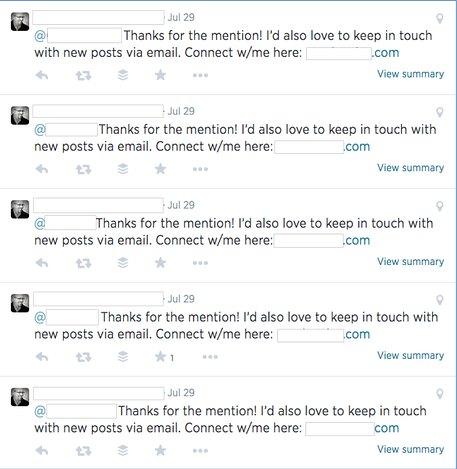 What’s the best way to connect with candidates when all you’ve got is a blue bird, 140 characters, some hashtags, a posse of followers, and a link to throw into the mix?
What’s the best way to connect with candidates when all you’ve got is a blue bird, 140 characters, some hashtags, a posse of followers, and a link to throw into the mix?
If you missed yesterday’s webinar on recruiting candidates using Twitter, we’ve compiled a list of key takeaways from the event. Check 'em out here!
Share great content – mix it up!
“If you’re just sharing job posts, you’re going to turn off your followers. This is your opportunity to take all of that employer branding and insight to your company and share it – it’s so easy to do,” Katrina said.
As mentioned in our Facebook recruiting webinar, recruiters can better engage with candidates by adding content variety to their feed, including photos, videos, articles, company updates, along with the occasional job posting. That way, job seekers can get a sense of your personality, interests, company culture, as well as the available opportunities that may be a good fit for them.
Remember: Your Twitter feed is not a broadcasting channel. It takes time to build a relationship with online candidates. Well-timed frequency, consistency, and quality content are the essential ingredients to getting and sustaining candidates’ attention.
Two rules to help you get started:
- IFTTT - If this, then that. There’s a cool tool (thanks, Internet) by the same name that allows users to trigger actions between several social networking sites, productivity tools, and online and mobile events (think emails, tags, location check-ins, text messages, reminders).
How does this work for recruiters? Katrina uses the tool to post her company’s Instagram photos to her company Twitter account not as Instagram links, but as photos, adding a visual element to a drone of text. - 411 - For every four tweets of others’ content, retweet one relevant piece of content, and one self-serving tweet. This rule was made popular by the folks at TippingPoint Labs and begs the question of the Twitter world: If a tweet is sent out and no on replies, favorites, or retweets it, is it heard?
Candidates won’t give your tweets or Twitter profile any attention if all you’re sharing includes job posting after job posting. In addition to IFTTT, the 411 rule offers a good starting place for recruiters curious about the content and consistency of their posts.
We’ve found that tweeting several (7-10) times throughout the day, from early morning (8 A.M.) through early evening (8:30 P.M.), works best with engaging with our audience. Find out what works best for your company and target audience by testing out a different number of scheduled tweets through various times of the day.
Revamp your daily routine and work on the day’s social media schedule first thing in the morning.
What’s the first thing you do when you get into the office? If it’s a jumble of reading, replying to, and deleting emails, there could be a more organized way to get your mind prepped and refreshed to start the day, and to take advantage of sharing timely, relevant articles your candidates may be interested in reading now. This can also ease the pressure of creating multiple pieces of original content to share every day.
Try this: Spend 10-15 minutes reading industry articles, then spend another 10-15 minutes sharing these articles through scheduled tweets.
Instead of scrolling through a never-ending inbox of newsletter subscriptions – a terrible time sink – use aggregated news applications like Feedly, Klout (now content-oriented), and Swayy to organize articles from all your favorite resources, and tools like Buffer or HubSpot to schedule tweets (and status updates on other social networks) throughout the day, keep track of your online engagement with followers, and analyze what time, days, and hashtags work best for connecting with your online audience.
Two hashtags, one tweet.
“Hashtags are absolutely crucial on Twitter. Don’t use them on LinkedIn – it looks lazy and unprofessional. On Twitter, you don’t want to use more than a couple…so it still looks readable and your tweet makes sense,” Katrina said.
Online job seekers are constantly scouring the web for open opportunities, and one way candidates keep track of new roles surfacing on Twitter is by searching #___fill job title here___. Recruiters posting job opportunities can make their tweets more searchable by using, at the most, two relevant hashtags in each of their tweets.
Try these hashtag tracking tools to find out what works for promoting your open reqs:
In Closing
Building a following is a work of progress and patience – remember that candidates pay attention to the number of followers and the number of users you’re following. If the first number is higher than the latter, this can harm your online credibility and clout. Be sure to have header and profile photos – are you an egg or a person? Avoid spamming followers with the same tweet or direct message, or risk looking like this:
Keep in mind that building a robust Twitter profile takes time, and a balance of automation and the human touch, of course. Schedule tweets so you’re not on Twitter all day searching for news to share and people to follow, but keep track of who’s favoriting, replying, and retweeting your updates to develop your online relationships with potential hires and customers, too!
Want a little more? Don’t forget to watch the webinar on demand in its entirety. We’ve also got the slide deck on deck just for you. One more thing – be sure to check out the rest of our social recruiting webinar series here!

